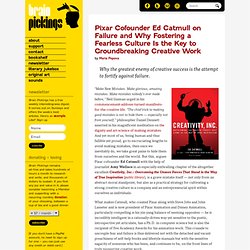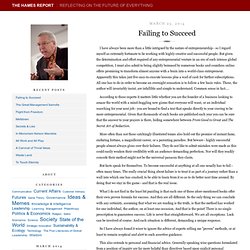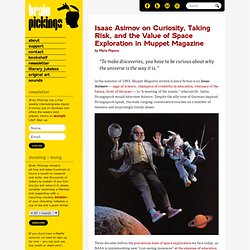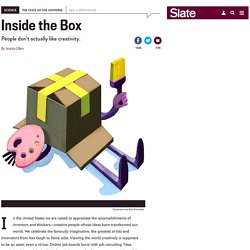

Kierkegaard on Anxiety & Creativity. By Maria Popova “Because it is possible to create — creating one’s self, willing to be one’s self… — one has anxiety.

One would have no anxiety if there were no possibility whatever.” Redefining success. Pixar Cofounder Ed Catmull on Failure and Why Fostering a Fearless Culture Is the Key to Groundbreaking Creative Work. By Maria Popova Why the greatest enemy of creative success is the attempt to fortify against failure.

“Make New Mistakes. Make glorious, amazing mistakes. Make mistakes nobody’s ever made before,” Neil Gaiman urged in his commencement-address-turned-manifesto-for-the-creative life. “The chief trick to making good mistakes is not to hide them — especially not from yourself,” philosopher Daniel Dennett asserted in his magnificent meditation on the dignity and art-science of making mistakes. What makes Catmull, who created Pixar along with Steve Jobs and John Lasseter and is now president of Pixar Animation and Disney Animation, particularly compelling is his yin-yang balance of seeming opposites — he is incredibly intelligent in a rationally-driven way yet sensitive to the poetic, introspective yet articulate, has a Ph.D. in computer science but is also the recipient of five Academy Awards for his animation work.
Sarah Lewis: Embrace the near win. Seth Godin on Vulnerability, Creative Courage, and How to Dance with the Fear: A Children’s Book for Grownups. By Maria Popova “If you just pick one human you can change for the better, with work that might not work — that’s what art is.”

At the 2014 HOW conference, Debbie Millman, host of the excellent interview show Design Matters and a remarkable mind, sat down with the prolific Seth Godin to discuss courage, anxiety, change, creative integrity, and why he got thrown out of Milton Glaser’s class. She used an unusual book of Godin’s as the springboard for their wide-ranging conversation: V is for Vulnerable: Life Outside the Comfort Zone (public library) — an alphabet book for grownups illustrated by Hugh MacLeod with a serious and rather urgent message about what it means and what it takes to dream, to live with joy, to find our purpose and do fulfilling work. I had the pleasure of seeing and recording the conversation — transcribed highlights below. On how moving away from the economy of scarcity is changing the motives for making books:
Bird by Bird: Anne Lamott’s Timeless Advice on Writing and Why Perfectionism Kills Creativity. By Maria Popova “Perfectionism is the voice of the oppressor, the enemy of the people.

It will keep you cramped and insane your whole life.” Anne Lamott’s Bird by Bird: Some Instructions on Writing and Life (public library) is among my 10 favorite books on writing — a treasure trove of insight both practical and profound, timelessly revisitable and yielding deeper resonance each time. Lamott adds to the collected wisdom of great writers with equal parts candor and conviction, teaching us as much about writing as she does about creativity at large and, even beyond that, about being human and living a full life — because, after all, as Lamott notes in the beginning, writing is nothing more nor less than a sensemaking mechanism for life: One of the gifts of being a writer is that it gives you an excuse to do things, to go places and explore.
I started writing when I was seven or eight. I still encourage anyone who feels at all compelled to write to do so. Secrets of The Phantom Tollbooth: Norton Juster and Jules Feiffer on Creativity, Anxiety, and Failure. By Maria Popova “Failure is a process … you have to fail over and over and over again to get anything that’s worthwhile.”

In 1961, a young architect by the name of Norton Juster received a grant for a book on urban perception and settled down at his house in Brooklyn Heights to write it. Struggling with the process, however, he began toying with a playful story about a boy named Milo in an effort to distract himself from the burden of his workload, and showed his drafts to his neighbor, an emerging political cartoonist named Jules Feiffer. Juster never wrote the urbanism book — instead, he teamed up with Feiffer and together they dreamt up The Phantom Tollbooth, which went on to become one of the most celebrated children’s books of all time, brimming with timeless philosophy for grown-ups — its map of The Kingdom of Wisdom alone is a profound metaphor for curiosity and the human condition.
Map of The Kingdom of Wisdom from ‘The Phantom Tollbooth’ Donating = Loving Share on Tumblr. 5 Timeless Books of Insight on Fear and the Creative Process. By Maria Popova From Monet to Tiger Woods, or why creating rituals and breaking routines don’t have to be conflicting notions.

“Creativity is like chasing chickens,” Christoph Niemann once said. But sometimes it can feel like being chased by chickens — giant, angry, menacing chickens. Whether you’re a writer, designer, artist or maker of anything in any medium, you know the creative process can be plagued by fear, often so paralyzing it makes it hard to actually create. The Hames Report. We are responsible not only for what we do but also for what we could have prevented Peter Singer - Ethicist Leaders across the world, young and old, men and women, in every sector of society, are encountering a moral dilemma that is fundamentally different from the many ethical dilemmas they face every day of the week.

What is far more intriguing is that possibly 99.9% of those in leadership positions go about their business entirely unconscious of this fact. Rather like the weird laws of quantum physics that reconstrue our reality, this issue is outside of their comprehension. So What's the Problem? In a word - ethics. Kathryn Schulz: On being wrong. Fixed vs. Growth: The Two Basic Mindsets That Shape Our Lives.
By Maria Popova “If you imagine less, less will be what you undoubtedly deserve,” Debbie Millman counseled in one of the best commencement speeches ever given, urging: “Do what you love, and don’t stop until you get what you love.

Work as hard as you can, imagine immensities…” Far from Pollyanna platitude, this advice actually reflects what modern psychology knows about how belief systems about our own abilities and potential fuel our behavior and predict our success. Reward Failure to Encourage New Ideas. Isaac Asimov on Curiosity, Taking Risk, and the Value of Space Exploration in Muppet Magazine. By Maria Popova “To make discoveries, you have to be curious about why the universe is the way it is.”

In the summer of 1983, Muppet Magazine invited science fiction icon Isaac Asimov — sage of science, champion of creativity in education, visionary of the future, lover of libraries — to “a meeting of the minds,” wherein Dr. Julius Strangepork would interview Asimov. Despite the silly tone of German-inspired Strangepork-speak, the wide-ranging conversation touches on a number of timeless and surprisingly timely issues. Three decades before the precarious state of space exploration we face today, as NASA is implementing new “cost-saving measures” at the expense of education and public outreach, Asimov speaks to the enormous cultural benefits of space exploration: Dr. On the relationship between space exploration and peace on earth: I don’t think we can really advance into space until we learn how to cooperate as a planet. T. S. Eliot on Idea Incubation, Inhibition, and the Mystical Quality of Creativity + a Rare Recording. Creativity is rejected: Teachers and bosses don’t value out-of-the-box thinking.
Illustration by Rob Donnelly In the United States we are raised to appreciate the accomplishments of inventors and thinkers—creative people whose ideas have transformed our world.

We celebrate the famously imaginative, the greatest artists and innovators from Van Gogh to Steve Jobs. Viewing the world creatively is supposed to be an asset, even a virtue. Creativity, the Gift of Failure, and the Crucial Difference Between Success and Mastery. By Maria Popova The lost art of learning to stand “where we would rather not and expand in ways we never knew we could.” “You gotta be willing to fail… if you’re afraid of failing, you won’t get very far,” Steve Jobs cautioned. “There is no such thing as failure — failure is just life trying to move us in another direction,” Oprah counseled new Harvard graduates. Treat Failure Like a Scientist. 5 Timeless Books of Insight on Fear and the Creative Process. Why we need creative confidence. In 2012, IDEO founder and longtime Stanford professor David Kelley took the TED stage in Long Beach and shared a deeply personal story.
It was the tale of his own cancer diagnosis, of finding a lump in his neck and being told he had a 40% chance of survival. This was clearly a sobering moment, but he wasn’t sharing the story to seek our sympathy. Rather, he wanted to talk about his resulting epiphany. “While you’re waiting for your turn to get the gamma rays, you think of a lot of things,” he said drily. “I thought a lot about: ‘What was I put on earth to do? His conclusion: “The thing I most wanted to do was to help as many people as possible regain the creative confidence they lost along their way.” Innovation is scary. The main thing that seems to work is to have a bunch of experiments where people dig in. So how do you embed innovation in an organization? The first thing a client doesn’t want to hear is that it’s probably a 10-year process. Fail Safe: Debbie Millman's Advice on Courage and the Creative Life.
By Maria Popova The seasonal trope of the commencement address is upon us as wisdom on life is being dispensed from graduation podiums around the world. After Greil Marcus’s meditation on the essence of art and Neil Gaiman’s counsel on the creative life, here comes a heartening speech by artist, strategist, and interviewer extraordinaire Debbie Millman, delivered to the graduating class at San Jose State University. The talk is based on an essay titled “Fail Safe” from her fantastic 2009 anthology Look Both Ways: Illustrated Essays on the Intersection of Life and Design (public library) and which has previously appeared on Literary Jukebox. The essay, which explores such existential skills as living with uncertainty, embracing the unfamiliar, allowing for not knowing, and cultivating what John Keats has famously termed “negative capability,” is reproduced below with the artist’s permission. If you imagine less, less will be what you undoubtedly deserve.